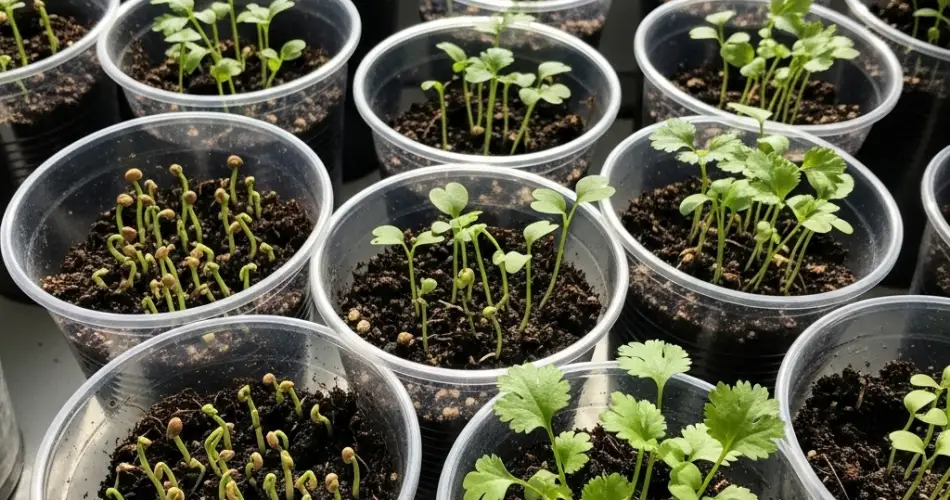Cilantro (Coriandrum sativum) is a popular herb known for its fragrant leaves and aromatic seeds, commonly used in a wide range of cuisines. However, many gardeners find cilantro seeds notoriously slow to germinate. It can take anywhere from 7 to 14 days for them to sprout, and in some cases even longer if conditions aren’t ideal. Fortunately, there are simple and effective techniques you can use to speed up the germination process and ensure a strong, healthy start for your cilantro plants.
If you’re eager to get your cilantro growing quickly, this guide will show you how to prepare, plant, and care for your seeds to encourage faster and more reliable germination.
Why Cilantro Seeds Germinate Slowly
Cilantro seeds are actually small fruits that contain two seeds inside a hard outer shell. This shell protects the seed but also slows down water absorption, which is crucial for triggering germination. Without help, it can take over a week for seeds to absorb enough moisture to sprout, especially in cool or dry conditions.
Speeding up germination involves overcoming this natural barrier while also providing the ideal environment for seeds to sprout.
Step 1: Choose Quality Seeds
Start with fresh, high-quality seeds. Older seeds tend to have lower germination rates and take longer to sprout. Make sure the packet is from a trusted source and hasn’t passed its expiration date.
For best results, look for organic, untreated seeds. Some commercially sold seeds are coated or treated with chemicals that can interfere with germination speed.
Step 2: Crush the Seed Hulls Gently
Since cilantro seeds are actually tiny seed pods containing two seeds, lightly crushing them can help speed up the process.
How to do it:
-
Place the seeds between two layers of paper towel or in a cloth bag.
-
Use a rolling pin or the flat side of a knife to gently crack the outer shell.
-
Be careful not to completely crush or damage the inner seeds.
This step helps moisture penetrate more easily and encourages both seeds inside each pod to sprout.
Step 3: Soak the Seeds
After gently cracking the seeds, soak them in water for 12 to 24 hours before planting. This step allows the inner seeds to absorb moisture and softens the outer shell further.
Tips for soaking:
-
Use lukewarm, non-chlorinated water for best results.
-
Change the water after 12 hours if you’re soaking for longer periods.
-
Do not soak for more than 24 hours, or the seeds may rot.
Soaking shortens germination time significantly and gives your seeds a head start.
Step 4: Pre-Sprout with the Paper Towel Method (Optional)
To gain even more control over the germination process, you can pre-sprout cilantro seeds before planting them in soil.
Here’s how:
-
Place the soaked seeds between two moist (not wet) paper towels.
-
Put the towels inside a zip-lock bag or airtight container.
-
Store in a warm, dark place such as on top of the refrigerator or inside a cupboard.
-
Check daily and mist the towels if they start to dry out.
You’ll typically see roots starting to emerge in 3–5 days. Once the roots appear, carefully transfer the sprouted seeds into soil.
Step 5: Provide the Right Growing Conditions
Even with good preparation, cilantro seeds still need the right environment to sprout quickly.
Ideal conditions include:
-
Temperature: Between 65–75°F (18–24°C) for optimal germination.
-
Soil: Well-draining, loose, and rich in organic matter. A mix of compost and potting soil works well.
-
Moisture: Keep the soil consistently moist but not soggy. Water gently so the seeds aren’t disturbed.
-
Depth: Plant seeds about ¼ to ½ inch (0.6 to 1.3 cm) deep.
-
Spacing: Space seeds about 2 inches apart. Thin out later if needed.
Covering the seedbed with a clear plastic dome or wrap can help retain humidity and warmth, speeding up sprouting.
Step 6: Avoid Overwatering or Letting Soil Dry Out
Cilantro seeds are sensitive to moisture balance. Too much water can lead to rot, while dry soil can stall germination.
Use a spray bottle or a fine watering can to keep the surface evenly moist. Avoid pooling water, and ensure the container or garden bed has good drainage.
Step 7: Light and Air Circulation After Germination
Once your seeds sprout, they’ll need plenty of light to grow strong and healthy.
-
Place seedlings in a sunny window or under grow lights for at least 6 hours a day.
-
Remove any plastic covers to allow airflow and prevent mold.
-
Avoid sudden temperature changes during the seedling phase.
Thin the seedlings when they reach 1–2 inches tall, leaving the strongest plants spaced 4–6 inches apart.
Final Thoughts
Cilantro can be a bit slow to get started, but with a few simple techniques—like cracking the seed pods, soaking, and pre-sprouting—you can greatly reduce the waiting time. Combine these steps with consistent moisture and warm temperatures, and you’ll be well on your way to growing fragrant, flavorful cilantro in just a matter of days. Whether you’re planting in containers or in the garden, these germination tips will help you enjoy fresh herbs sooner and with greater success.



